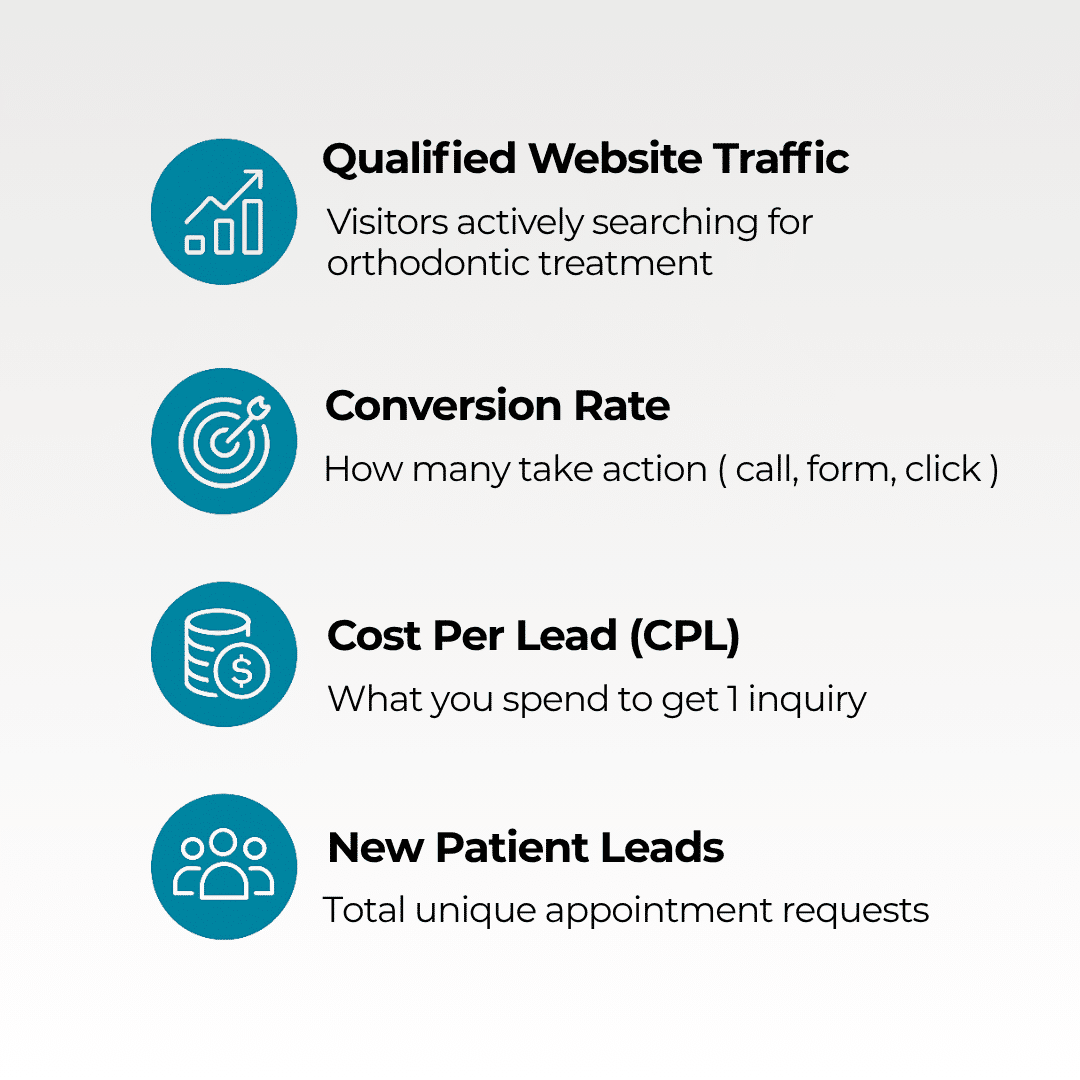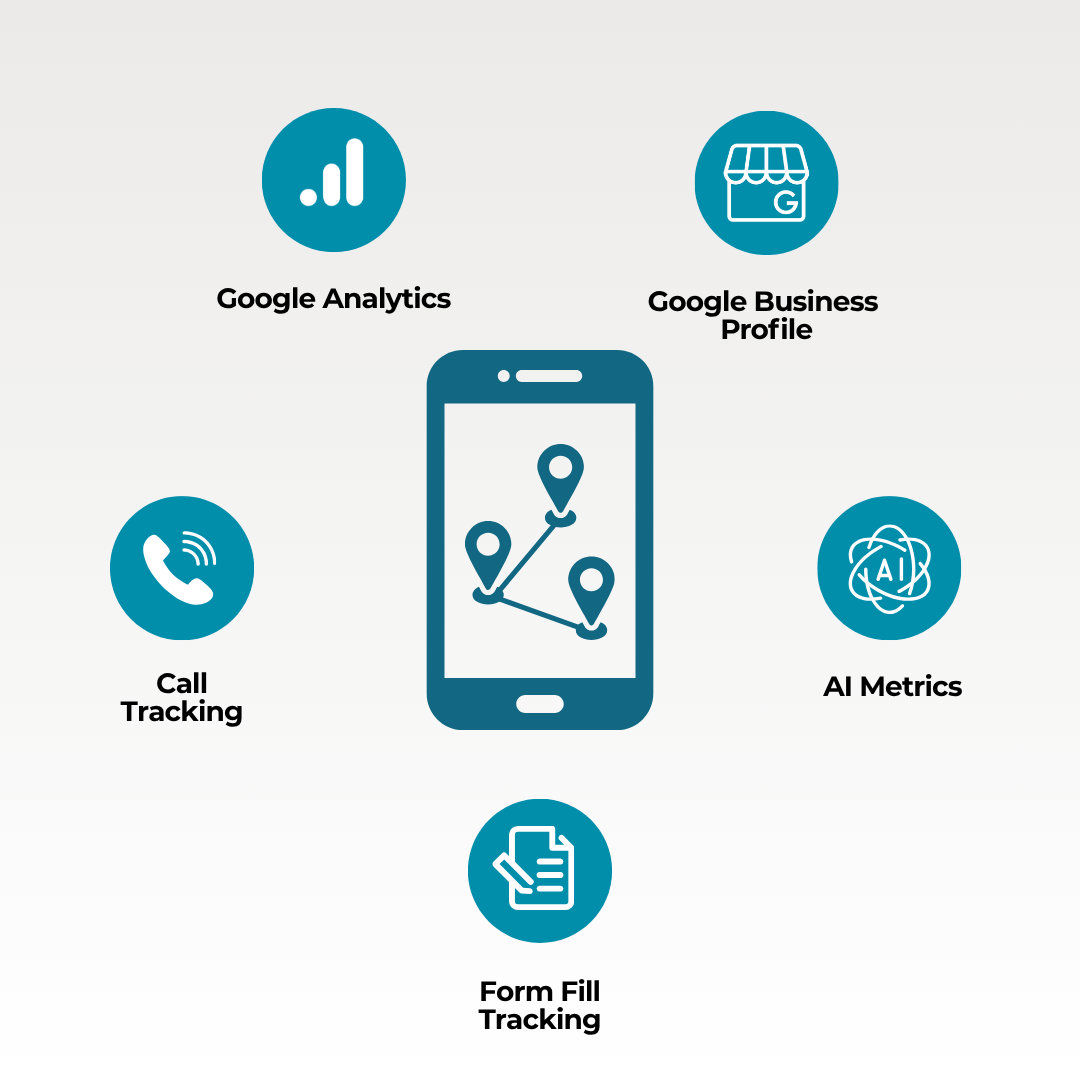What Are the Most Important Digital Marketing Metrics for Orthodontists?
Orthodontists should prioritize actionable marketing metrics, those that clearly indicate whether your efforts are bringing in new patients for ROI. With the disruption of AI affecting all digital marketing metrics in 2025, it is imperative to understand which metrics are the most effective when managing your marketing strategy:
- Qualified Website Traffic – Visitors actively searching for orthodontic treatment near you.
- Conversion Rate – How many website visitors take an action (e.g., call your office or fill out a form), especially with online ads.
- Cost Per Lead (CPL) – The amount of money you spend to generate one new inquiry with online advertising.
- New Patient Leads – Total number of unique appointment requests or contacts from local search results, social media, online ads, and word of mouth referrals.

Why Should Orthodontists Avoid Tracking Too Many Marketing Metrics?
Too many practices suffer from “analysis paralysis.” They track dozens of metrics, impressions, likes, and views, without a clear connection to new patient growth. These “vanity metrics” might look impressive, but they don’t tell you whether your marketing is working.
Focusing on the wrong data leads to:
- Wasted time reviewing irrelevant numbers
- Wasted money on ad campaigns that don’t convert
- Missed opportunities to optimize what actually works
Instead, streamline your focus to metrics that directly answer the question: “Are we attracting and converting more patients?”
How Can Orthodontists Spot Red Flags in Their Marketing Metrics?
Certain data points act as warning signs that your strategy may need a change. Here are key red flags to watch:
- High Bounce Rate: “One and done!” Visitors leave your website without clicking into a second page. Your landing page might be confusing, slow, or off-target. A bounce rate above 60% is considered high.
- Low Ad Engagement: Lots of impressions but very few clicks suggest that your ad message isn’t connecting. The click-through rate in orthodontics is typically above 5% with the correct setup.
- High CPL with No Results: If you’re spending money on digital ads but seeing few or no qualified leads, the problem may be your targeting or offer. You could be reaching the wrong audience, or promoting a message that doesn’t resonate.
Without a solid tracking system in place that captures both phone calls and form submissions, it becomes challenging to measure your valid CPL. One common mistake is sending ad traffic to your website’s homepage. This makes it nearly impossible to track conversions accurately or connect leads back to specific campaigns.
For meaningful insight, every ad should lead to a dedicated, trackable landing page with clear calls to action to your front desk with patient names and contact information to cross-reference with your practice management system. Identifying these signs early helps prevent wasted ad spend and ensures your campaigns stay effective.
What Marketing Metrics Should Orthodontists Track Monthly?
Set a recurring monthly review using this simple checklist:
- New Patient Leads – Indicates growing interest and appointment activity
- Conversion Rate – Measures how well your site turns visitors into leads
- Qualified Traffic – Ensures your audience is the right fit
- Cost Per Lead (CPL) – Tracks how efficiently you’re spending marketing dollars
What Tools Help Orthodontic Practices Track These Metrics?
To decode your digital data clearly and effectively, use these essential tools:
- Google Business Profile Monthly Free Report – For orthodontic practices, this report is a valuable snapshot of how your business is performing in local search month to month through word of mouth and provides top keywords patients use to find you, and helps track key patient engagement metrics. If the top keywords are the practice name or doctor name, your word of mouth is strong in the area.
- Google Analytics – For understanding where your visitors are coming from and how visitors interact with your website, and the fluctuation in traffic in comparison to other timeframes.
- Google Search Console – Does your webmaster track your website’s visibility on Google every month and course correct as needed?
- Call Tracking – Links ads to actual phone calls and inquiries. Most also record the call, allowing you to assess the quality of leads and track your team’s conversion rates.
- Form Fill Tracking – In orthodontics, form fills are the most common contact with ad programs. It also allows you to cross-reference with your practice management system to determine if the patient was actually scheduled and converted to treatment for ROI. The only leads that count are those that started treatment or were placed in your recall system for future treatment.

How Do I Know If My Orthodontic Marketing Is Working?
Ask yourself these simple questions monthly:
- Are we receiving more inquiries from potential patients?
- Are our website visitors turning into actual appointments?
- Is our cost to acquire new patients going down with ads?
- Are current patients referring others?
If you’re not sure how to answer these, it’s time to get help.
Who Can Help Me Understand My Orthodontic Marketing Data?
Kaleidoscope Digital Marketing specializes in turning confusing orthodontic marketing reports into clear, actionable strategies. Whether you need to:
- Improve your ROI
- Decode your performance trends
- Or launch better-targeted digital ad campaigns

Our team is ready to support you every step of the way. Schedule your free consultation today and stop guessing. Start growing with confidence.
